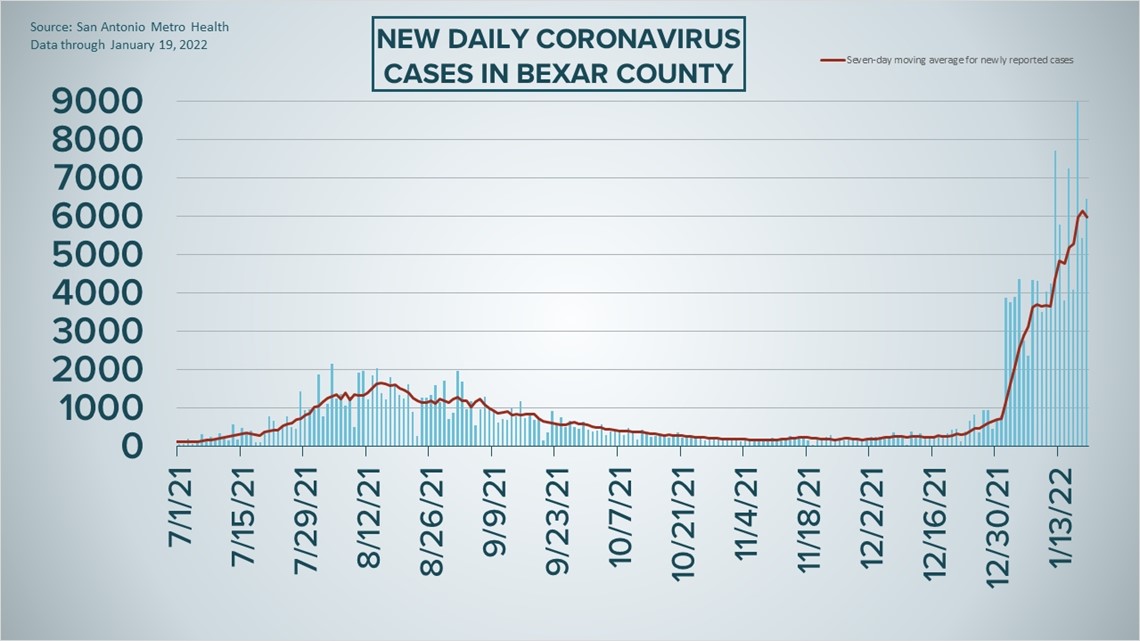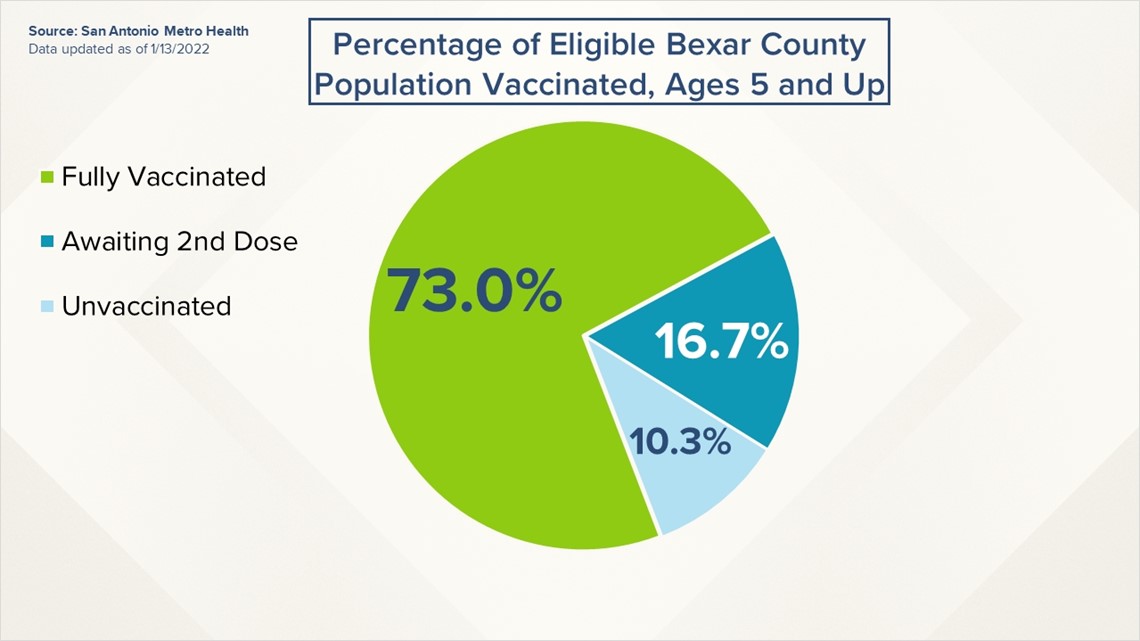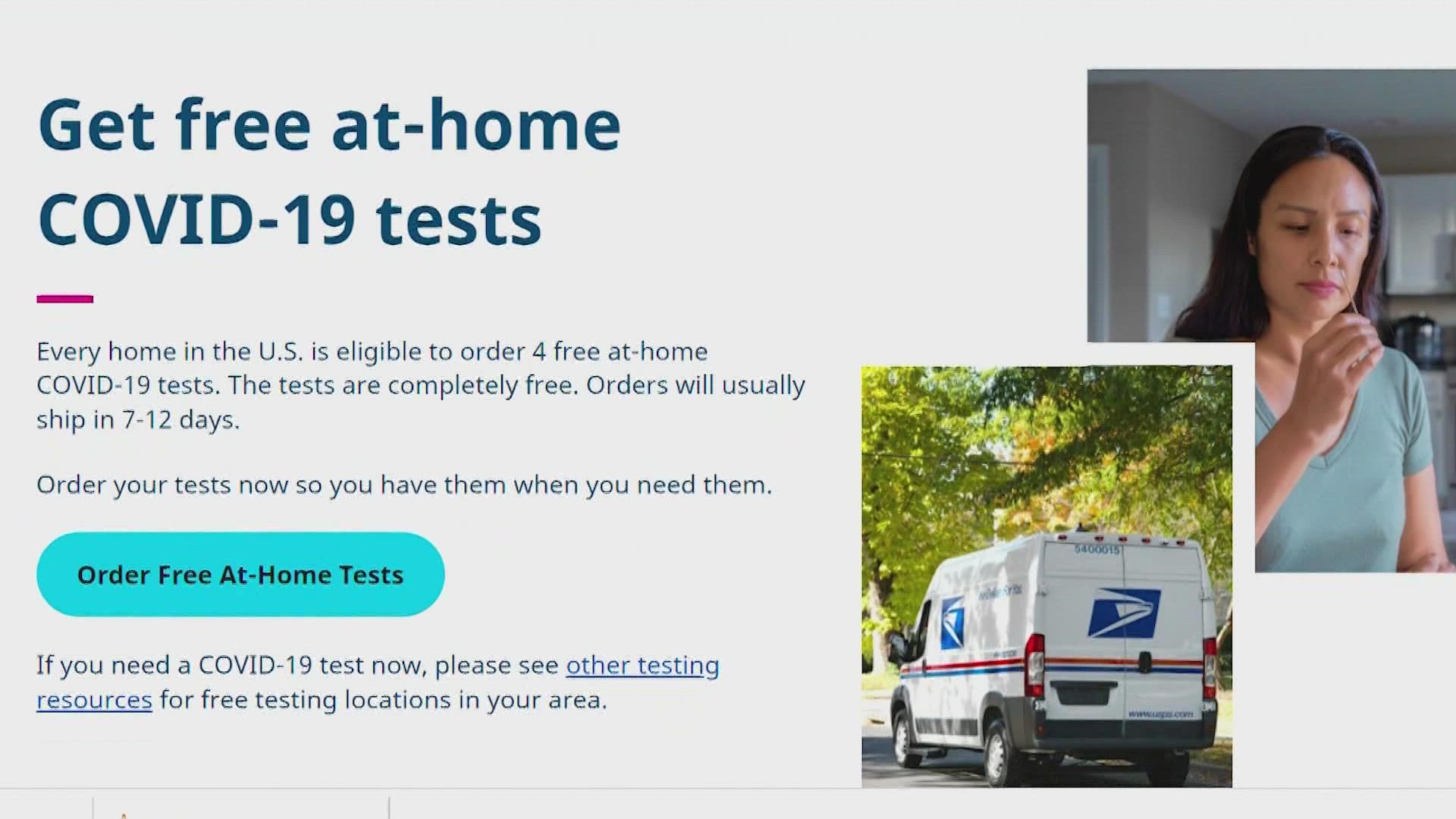SAN ANTONIO — Bexar County health officials recorded 6,450 new COVID-19 cases on Wednesday as the current surge – the worst of the pandemic thus far, at least when it comes to new diagnoses – continues in the San Antonio area, exacerbated by the highly contagious omicron variant.
Metro Health also retroactively increased its Saturday case count from 1,248 to 7,230, saying that thousands of new cases were "added by the state." In all, 431,846 Bexar County residents have been diagnosed with COVID-19, while the seven-day average stands at 5,961.
Omicron continues to put newfound strain on local health care facilities too, as the number of San Antonio-area hospitalizations rose for the 26th straight day. On Wednesday 1,218 local residents were receiving treatment for COVID-19, the highest number of hospitalizations since early September.
Metro Health also reported five new virus-related deaths for our area, raising the local death toll during the pandemic to 5,018.
The positivity rate for Bexar County is also at the highest level it's ever been, with 38.3% of lab-provided tests returning a positive coronavirus diagnosis. Long lines have been spotted at various testing sites across the city in recent weeks, and on Tuesday a federally operated testing site opened at the Alamodome to help with the demand.
How Bexar County is trending




Vaccine Progress in Bexar County
The following numbers are provided by San Antonio Metro Health. A full breakdown can be found here.
- 1.699 million eligible Bexar County residents have received at least one dose of the coronavirus vaccine as of Thursday, Jan. 13, representing 89.7% of the county's population eligible (those over the age of 4) to receive a vaccination.
- 1.383 million eligible Bexar County residents are fully vaccinated as of Thursday, Jan. 13, representing 73% of the county's population eligible to receive a vaccination.


The CDC states that "when a high percentage of the community is immune to a disease (through vaccination and/or prior illness)," that community will have reached herd immunity, "making the spread of this disease from person to person unlikely."
The City of San Antonio breaks down the vaccination rates by zip code on Metro Health's Vaccination Statistics page.
Coronavirus in Texas
The total number of coronavirus cases in the state since the pandemic began grew by 56,047 on Wednesday, according to the Texas Department of State Health Services. That total includes 47,966 new confirmed cases and 8,081 new probable cases. More details can be found on this page.
Wednesday's figures bring the total number of Texans diagnosed with COVID-19 to more than 5.7 million.
An additional 154 Texans have died from virus complications, meanwhile, raising the statewide death toll to 76,277.
Coronavirus symptoms
The symptoms of coronavirus can be similar to the flu or a bad cold. Symptoms include fever or chills, cough, shortness of breath or difficulty breathing, fatigue, muscle or body aches, headache, new loss of taste or smell sore throat, congestion or runny nose, nausea or vomiting, and diarrhea, according to the Centers for Disease Control.
Most healthy people will have mild symptoms. A study of more than 72,000 patients by the Centers for Disease Control in China showed 80 percent of the cases there were mild.
But infections can cause pneumonia, severe acute respiratory syndrome, kidney failure, and even death, according to the World Health Organization. Older people with underlying health conditions are most at risk.
Experts determined there was consistent evidence these conditions increase a person's risk, regardless of age:
- Chronic kidney disease
- COPD (chronic obstructive pulmonary disease)
- Obesity (BMI of 30 or higher)
- Immunocompromised state (weakened immune system) from solid organ transplant
- Serious heart conditions, such as heart failure, coronary artery disease, or cardiomyopathies
- Sickle cell disease
- Type 2 diabetes
- The CDC believes symptoms may appear anywhere from two to 14 days after being exposed.
Human coronaviruses are usually spread...
- Between people who are in close contact with one another (within about 6 feet).
- Through respiratory droplets produced when an infected person coughs, sneezes or talks. These droplets can land in the mouths or noses of people who are nearby or possibly be inhaled into the lungs.
- Some recent studies have suggested that COVID-19 may be spread by people who are not showing symptoms.
Help stop the spread of coronavirus
- Stay home when you are sick.
- Eat and sleep separately from your family members
- Use different utensils and dishes
- Cover your cough or sneeze with your arm, not your hand.
- If you use a tissue, throw it in the trash.
Find a Testing Location
City officials recommend getting a COVID-19 test if you experience fever or chills, cough, shortness of breath or difficulty breathing, fatigue, muscle or body aches, headache, new loss of taste or smell, sore throat, congestion or runny nose, nausea or vomiting, or diarrhea.
Here's a Testing Sites Locator to help you find the testing location closest to you in San Antonio.
Latest Coronavirus Headlines
- Coronavirus Tracker: San Antonio's total cases surpasses 425,000
- Federal COVID-19 testing site opens at the Alamodome
- Tickets for Winter Olympics won't be sold to general public
- New Austin COVID-19 orders go into effect this week
- Texas mother who lost daughter to flu shares importance of getting vaccinated
- Verify: Masks do help those with cedar fever
- Here are San Antonio's pop-up coronavirus vaccine clinics for Jan. 15 to Jan. 22
- Interest in N95 masks grows as omicron cases rise nationwide

